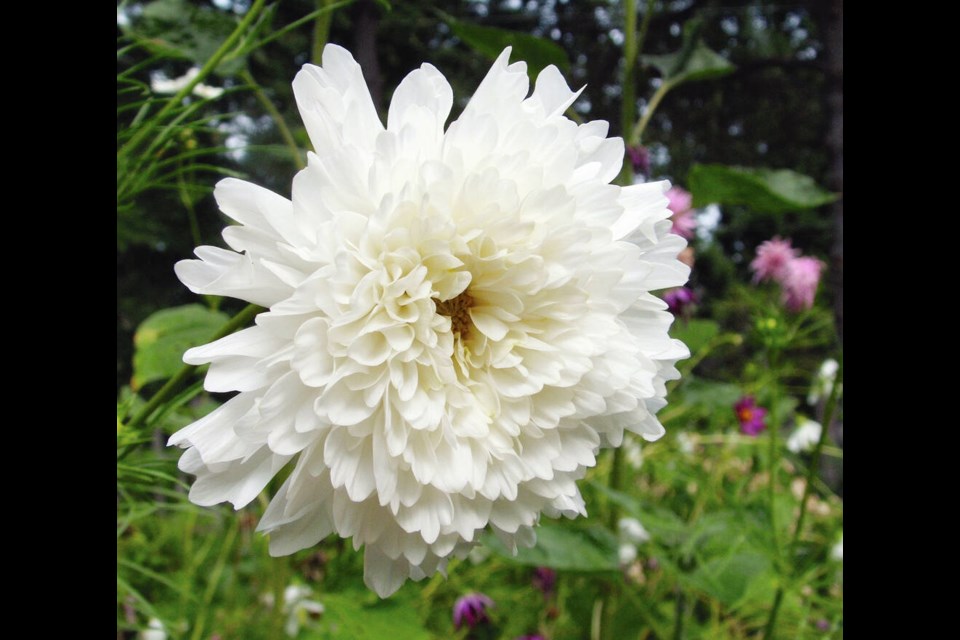Dear Helen: I have long been fond of Sensation Mix cosmos, which I grow in my garden every year. Last year a friend showed me some double-flowered plants she said were cosmos. I thought all cosmos were single daisy flowers in white and pink.
P.F.
Sensation Mix remains the standard cosmos star, since its introduction as an award-winning flower in 1936. Over the years many new varieties have emerged, with colours branching into yellow (Xanthos) and Apricotta, a single daisy flower with warm apricot tones on soft pink.
Apricotta and Sonata, a colour mixture, are European Fleuroselect award winning flowers, as is the white Snow Puff in the Double Click series. Velouette has won both Fleuroselect and Royal Horticultural Society awards for its range of solid colours with some striped blooms.
I’m growing most of these this year, along with Rose Bon Bon, another colour in the Double Click series.
Dear Helen: Every spring, plants with strong stems, grassy foliage and blue flowers take over a couple of flower beds in my garden. I keep pulling them out but they persist. Can you identify the plants from the photos I am sending?
J.H.
I have clumps of plants just like the ones in your photos. They are Spanish bluebells, bulb flowers that naturalize easily and can become invasive if allowed to spread, which they do easily by seed and bulb offsets. Bluebells have become invasive in local parks
I have several small clumps at plot corners that I keep from spreading by digging up any stray plants and by stripping spent flower stems of seeds. I do this by closing fingers at the base of the stem and pulling, bringing the seeds along with me. I do not compost the seeds.
The problem with pulling up the plants is that each parent bulb produces little offset bulbs, which are usually left behind in the soil. I have a similar problem with some flowering onions gone rogue. Pulling them up always reveals the presence of more than the main bulb.
Digging carefully, with a thorough sifting through the soil for baby bulbs, is more efficient than pulling, though even that does not guarantee complete removal of all the little bulbs. Still, removing seeds and careful digging are the most promising measures for controlling the plantings.
Dear Helen: Over the winter we’ve accumulated a significant amount of ashes from our wood stove. Are there safe uses for them in the garden?
F.L.
Wood ashes are high in potash and they are highly alkaline. A friend once pointed out a hydrangea that presented a puzzle in her garden. The normally brilliant blue flower clusters had turned a muddy pink. The reason for the disappointing colour change was a bucket of wood ashes her husband had dumped on the soil around the shrub.
The alkaline effect on the soil was enough to effect the colour change. To maintain a vibrant blue colour in hydrangea flowers, the soil needs to be moderately acidic, with a pH of around 5.5 on a scale of 14, with 7 denoting a neutral pH and higher numbers indicating varied levels of alkalinity.
Keep wood ashes away from acid loving plants like rhododendrons, camellias, azaleas and blueberries. Because our west coast soils tend to be acidic, ashes used moderately can be help to counter acidity where a more neutral or slightly alkaline soil is called for in the soil preparation or/and care for plants like mock orange, peony, clematis lilacs, asparagus and beets. It is easy enough to find preferred pH levels for individual plants online.
Ashes can be safely sprinkled on compost heaps, between layers of a building pile. Finished (decomposed) compost tends to be nitrogen-rich, and the potash in the ashes acts as a counter to nitrogen, which fosters lush green, vegetative growth while potash (potassium) hardens cells for sturdiness and resistance to pests and diseases. This nutrient also helps in the formation of flowers and fruit.
Nitrogen and potassium are two of three major plant nutrients. The third is phosphorus (the middle number on fertilizer labels). Phosphorus promotes root, fruit and seed development.
GARDEN EVENT
Dahlia meeting. The Victoria Dahlia Society will meet on Thursday, June 6, at 7 p.m. in St. Michael’s Church, 4733 West Saanich Rd. Award-winning hybridizer Connie Young-Davis will explain how to successfully grow your newly planted dahlias. Visitors are welcome.



